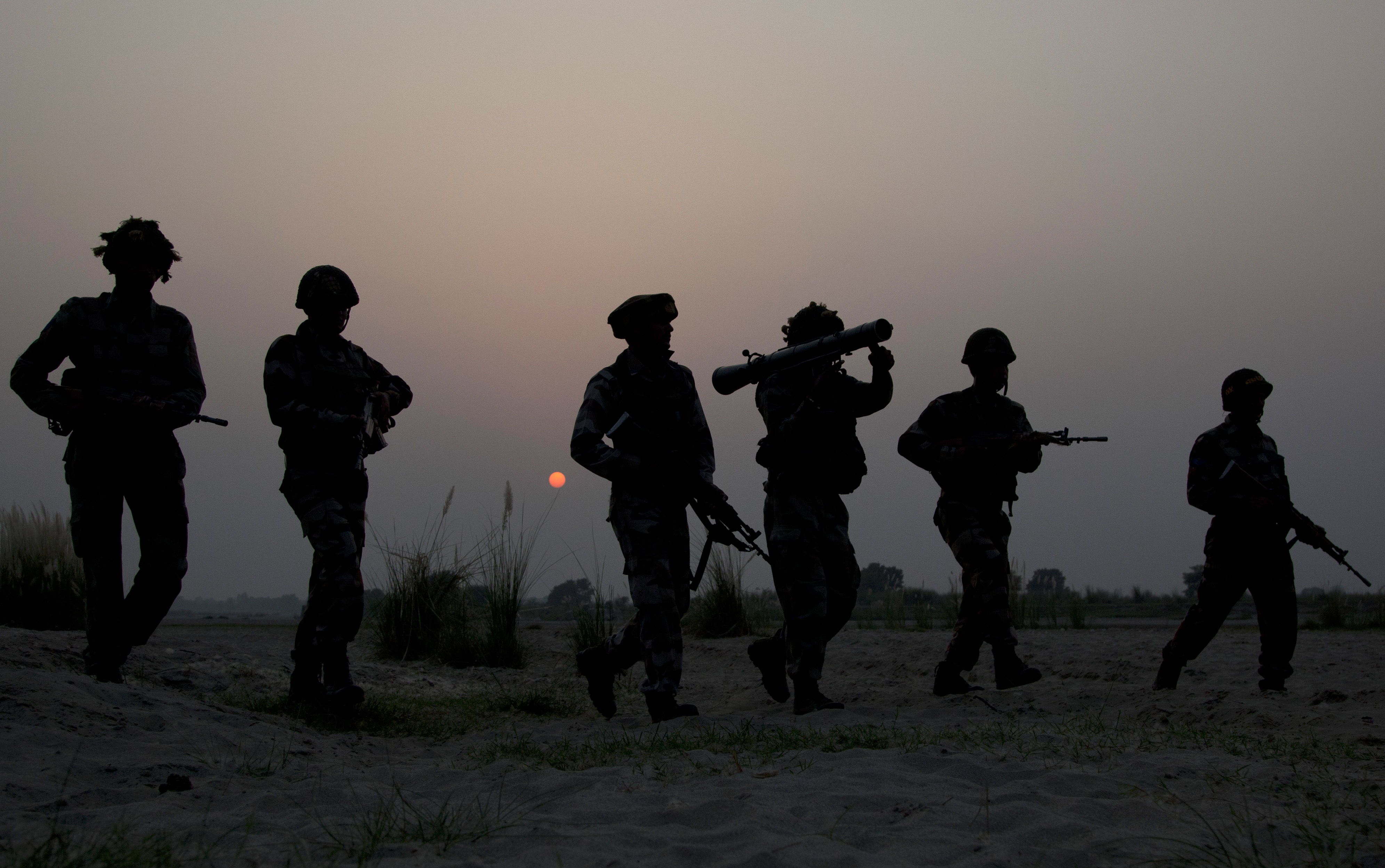Russian flamethrower ‘Shmel’ spearheaded surgical strikes

Indian army soldiers patrol near the highly militarized Line of Control dividing Kashmir between India and Pakistan, in Pallanwal sector, about 75 kilometers from Jammu, India, Oct. 4, 2016.
APWhen India’s Special Forces crossed the Line of Control (LoC) on the night of September 28, they attacked the terrorist camps with a variety of deadly weapons. According to investigative reporter and author Vicky Nanjappa, the commandos destroyed their targets with grenade launchers, rocket launchers and Shmel infantry flamethrowers.
Two days after the Uri attack, the Intelligence Bureau signalled to the army that it had picked up chatter which suggested that a big batch of terrorists would be moving closer to the LoC, says Nanjappa. The armed forces wanted the big batch to move in completely before launching this strike. One officer said there was no point in crossing the LoC and just destroying the launch pads. They would have built new ones immediately.
“Our intention was to inflict maximum damage and we wanted to snuff out their lives," the officer pointed out.
 Source: Public domain
Source: Public domain
The Indian Army first targeted terror training camps up to 20 km deep inside Pakistan-occupied Kashmir (PoK) with heavy artillery. The terrorists scattered under the surprise artillery fire and took shelter in launching pads along the LoC. The Special Forces commandos then entered PoK.
From the get-go, the LoC strike was a take-no-prisoners mission. “The forces were told to just hit them and return,” says Nanjappa. The weapons were chosen to inflict the maximum casualties possible. Instead of using their assault rifles, the Indian commandos opened fire with rocket launchers and Shmel flamethrowers from the moment they came within range of these camps.
The Russian made ‘Shmel’ has the effect of a mini nuclear weapon and is designed to pulverise its target. The word flamethrower is in fact a misnomer because it is not a flame spewing weapon. The Shmel fires a ‘thermobaric’ warhead which works by dispersing a highly flammable fuel vapour, then igniting this cloud while it hangs over the target. The resulting blast generates a 3000-degree Celsius fireball that not only causes powerful burns but also a high pressure shockwave that sucks out all the oxygen an area of 50 square metres outdoors and 80 cubic metres indoors.
In each of the terrorist launch pads across the LoC, there were around five terrorists. Many of them would have been shredded to bits in their sleep. Those in the vicinity of the explosion would have suffered horrendous internal injuries from the compression. Even for a jehadi terrorist prepared for a one-way suicide mission, it is an incredibly unpleasant way to go.
Soviet and Russian troops who used the weapon in Afghanistan and Chechnya often talk about how a thermobaric shell blast inside a one-story stone house would literally throw the entire roof into the air. A direct hit on a light armoured vehicle or personnel carrier is also guaranteed to knock it out. The Afghan Mujahidin referred to the Shmel as “Shaitan’s (the Devil’s) Pipe”.
According to Nanjappa, the Lashkar-e-Taiba may have lost at least 20 of its terrorists in the strike while 18 belonged to the Jaish-e-Mohammad. There are other media reports that say much larger numbers of terrorists and Pakistan Army soldiers may have perished.
The number of enemy casualties in the raid will never be known because as is the Pakistan Army’s habit, it would have hidden the dead bodies. Most likely, bulldozers would have been used to remove all evidence. During the 1999 Kargil War, the Indian Air Force attacked the Northern Light Infantry troop concentrations, resulting in hundreds of dead Pakistani soldiers. However, the Pakistan Army refused to take back its dead and it was the Indian Army that gave enemy soldiers a quiet burial.
Flamethrowers: Deadly in any era
A US Army report notes that flamethrowers are still “an important asset in the Russian manoeuvre commander’s toolbox.” It cites a full report on Russia’s use of flamethrowers from the Foreign Military Studies Office, an open source research organization of the US Army.
The report isn’t written in a critical tone. It says that at a time when other armies are re-evaluating the value of flamethrowers, Russia has demonstrated their “usefulness for urban and mountain warfare, bunker busting, and clearing light infantry”.
“From a Russian military perspective, flamethrowers are seen not as weapons simply to be handed out to the rank-and-file for any ad-hoc use, but instead as a mature weapon system that filled specific capability gaps in the Russian Armed Forces force structure," notes OE Watch, the US Army Foreign Military Studies Office's monthly newsletter.
OE Watch interpreted Russia's expansion of thermobaric units as a sign the Kremlin is preparing for urban warfare in the future.
"As Russia experiments with new forms and methods of war, or 'hybrid war' as defined in the West, in Eastern Ukraine, urban warfare will likely continue to be a high priority for development, and so will Russia's flame-wielding NBC defence troops."
The 93 mm calibre Shmel comes in three varieties – fuel-air explosive or thermobaric (RPO-A), smoke composition (RPO-D) and incendiary composition (RPO-Z). The blast effect of the thermobaric warhead is roughly equivalent to the blast effect of a 107 mm high explosive artillery shell.
All rights reserved by Rossiyskaya Gazeta.
Subscribe
to our newsletter!
Get the week's best stories straight to your inbox

